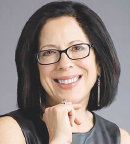The development of complex biomarkers such as tumor mutational burden (TMB) has enabled clinicians to identify patients more likely to respond to treatment of a variety of cancers, leading to more accurate diagnoses and improved outcomes. Differences in testing assays, however, have produced inconsistent reporting in the clinical setting. For its first-ever virtual symposium, Friends of Cancer Research (Friends) invited a trio of experts to discuss the evolution of tumor mutational burden and ongoing efforts to support a standardized method of measurement.

Elizabeth M. Jaffee, MD, FAACR

Richard Pazdur, MD

Eric H. Rubin, MD
Elizabeth M. Jaffee, MD, FAACR, a medical oncologist and Deputy Director of The Sidney Kimmel Comprehensive Cancer Center at Johns Hopkins, was joined by Richard Pazdur, MD, Director of the Oncology Center of Excellence at the U.S. Food and Drug Administration (FDA), and Eric H. Rubin, MD, a medical oncologist and Vice President of Clinical Oncology at Merck.
From Microsatellite Instability to Tumor Mutational Burden
As Dr. Rubin explained, although early work with checkpoint inhibitors in colon cancer yielded limited activity, there were outliers who had strong responses. Researchers hypothesized that defects in DNA mismatch repair genes, which were characteristic of certain types of colon cancer and associated with very high mutation rates, might produce neoantigens that could be recognized by the immune system. Patients with this condition, called microsatellite instability (MSI), would thus make good candidates for checkpoint inhibition.
A small trial of patients with MSI-high colon cancer expanded to two additional tumor types and was soon followed by a successful basket study. What’s more, said Dr. Rubin, approval of immunotherapy for patients with MSI-high cancer opened the doors to testing for tumor mutational burden.
“Because we knew there were other ways to generate high mutation rates beyond those identified with an MSI screening test, we were worried we might be leaving patients behind if we didn’t study those tumors too,” commented Dr. Rubin.
The idea may have been a natural extension of the research with MSI-high testing, but quantifying tumor mutations is far more complicated than observing a deficiency in the mismatch repair system. Although tumor mutational burden is extrapolated using sequencing data of a gene panel of more than 2,000,000 base pairs of coding region, microsatellite instability is calculated based on more than 2,000 markers. Making tumor mutational burden work required alignment across various diagnostic and therapeutic companies as well as basic agreement about the definition of the biomarker.
“Unlike the MSI test, which is either positive or negative, with TMB, there is a range of mutation numbers that can occur in a given patient, and this creates quite a bit of complexity,” Dr. Rubin said. “It was only through the efforts of the FDA and organizations such as Friends that various stakeholders came together to settle on a definition. This enabled a proper study of the TMB-high population and ultimately led to approval.”
Tumor-Agnostic Indications
Now, aided by complex biomarkers such as TMB and MSI-high, cancer treatment is no longer defined or constrained by a tumor’s location in the body. As long as they have the same quantity of mutations, two tumors in different parts of the body may be treatable by the same therapy. (The higher the number of mutations in a tumor’s genome, the more likely a patient is to respond to treatment.)
Although tumor mutational burden has been a significant breakthrough and is now regarded as part of routine diagnostics, Dr. Pazdur acknowledged that getting to this point has not been easy. Stakeholders were forced to embrace an approach that differs significantly from classic drug development for specific tumor types. Pharmaceutical companies, for example, had to develop drugs in tandem with accompanying diagnostics, which posed numerous regulatory challenges. Thanks to response rates that have approached 80%, however, the FDA has already approved four tissue-agnostic cancer drugs.
“In the past, we have had to argue over whether or not a drug even works,” said Dr. Pazdur. “Now, we’re often asking, ‘how fast can we get this application?’”
“In a way, these approvals point to a redefining of disease,” he added. “I think tumor-agnostic indications will be the future of oncology.” Tumor-agnostic indications may be the future, but there is still a lot of work to be done, including standardizing the methods of measurement and achieving consensus across a number of assays.
“Different methods have been used to calculate and report tumor mutational burden, with various approaches to filter somatic mutations,” said Dr. Rubin, who noted that a mutation rate of 10 on a single test may mean something else on another. “Friends has helped pool data from various companies and facilitate discussion among stakeholders to determine meaningful cutoffs for high tumor mutational burden.”
Improving Access to New Treatments
Dr. Jaffee also underscored the importance of openness to innovation among all stakeholders, patients included. “I’ve been involved in drug development for 30 years, and it’s obvious to me how much the FDA, industry, biotech, and academia have really come together,” she related. “Not everyone may have appreciated their role 10 years ago, but the patient community has also become a critical part of what we do.”
Although complex biomarkers have helped generate “remarkable responses” to treatment, patient access is still largely limited to the academic setting, said Dr. Jaffee. And this access has become even more restricted during the COVID-19 pandemic.
“We need to figure out, as a society, as physicians, and as drug developers, how to get these drugs to underrepresented groups and study them early in those groups,” concluded Dr. Jaffee. “It’s a tough time for everybody, but it’s particularly tough for patients with cancer. I feel the community as a whole is working doubly hard, maybe triply hard, to make sure our patients have access to these therapies.”
DISCLOSURE: Dr. Jaffee has served as a consultant or advisor to Adaptive Biotechnologies, CStone Pharmaceuticals, Dragonfly Therapeutics, Genocea Biosciences, and Incyte; has received research funding from Aduro Biotech, Amgen, Bristol Myers Squibb, and Corvus Pharmaceuticals; holds intellectual property in GVAX; has been reimbursed for travel, accommodations, or other expenses by Bristol Myers Squibb, Genocea Biosciences, and MedImmune; and has held other relationships with Dragonfly Therapeutics. Dr. Pazdur is employed by the U.S. Food and Drug Administration. Dr. Rubin is employed by Merck & Co and holds stock or other ownership interests in Merck & Co.

